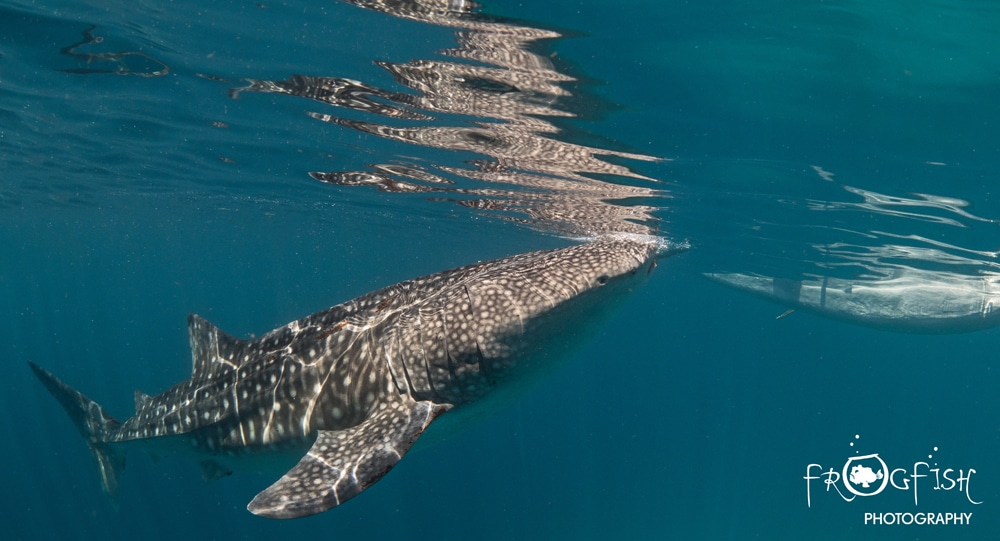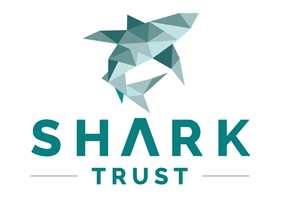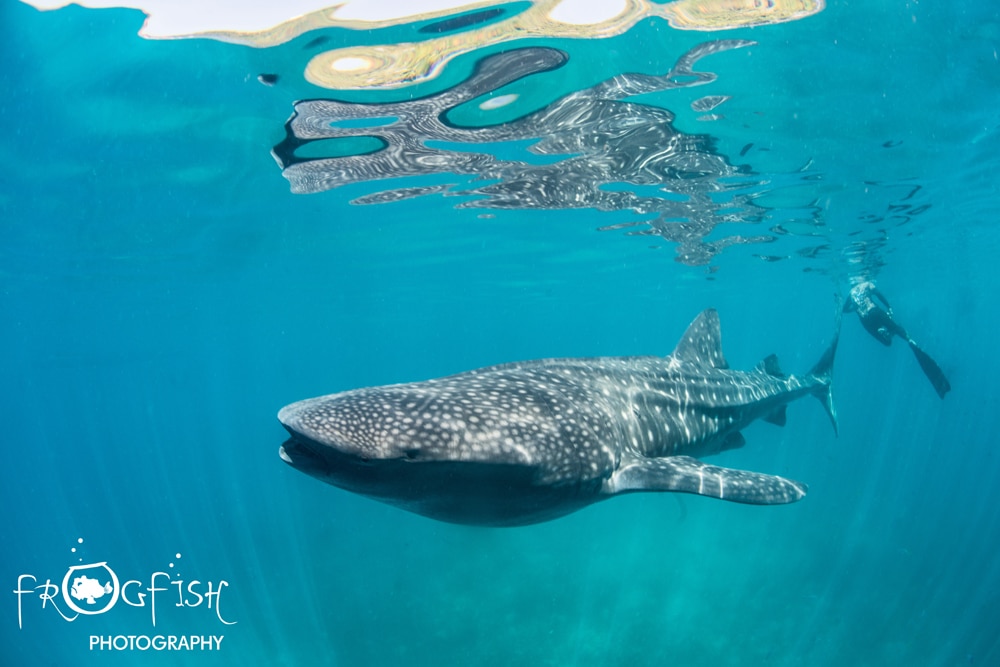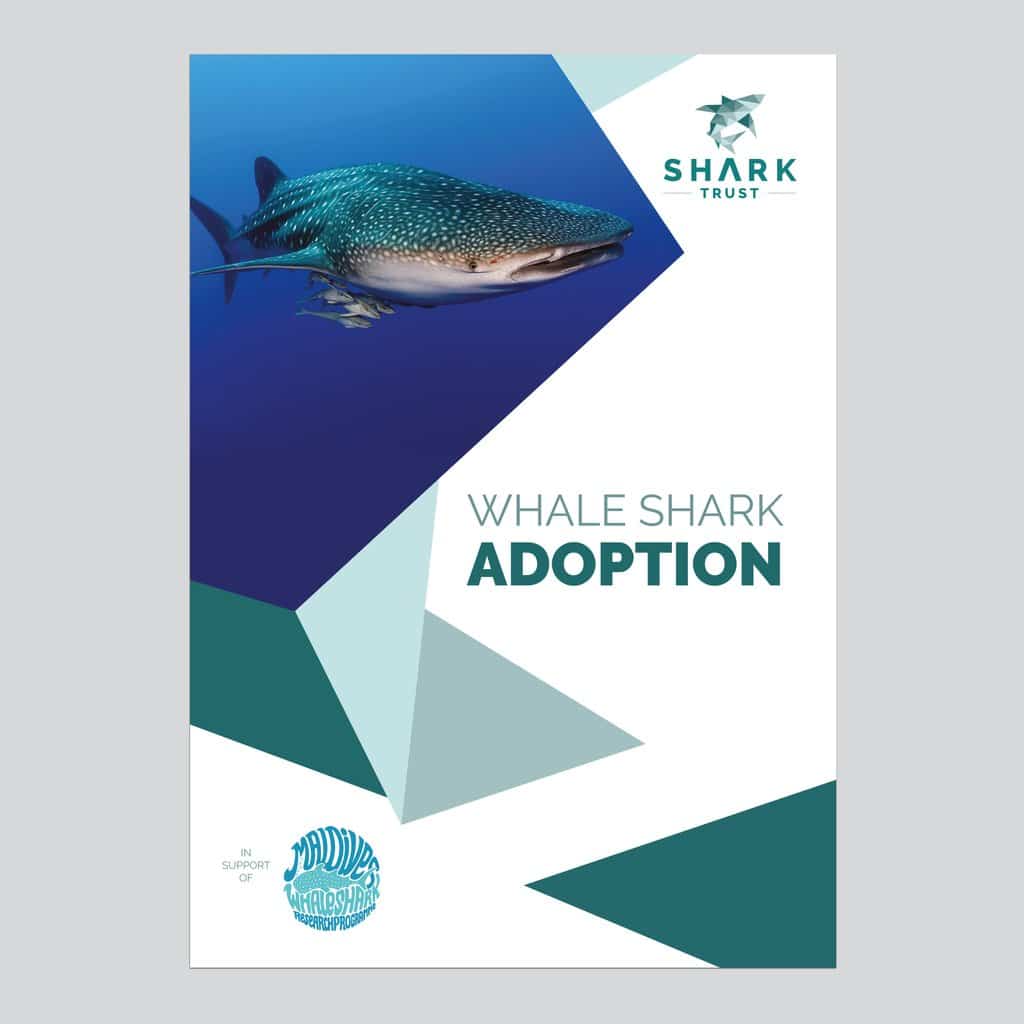Marine Life & Conservation Blogs
Creature Feature: Whale Shark

 In this new series, the Shark Trust will be sharing amazing facts about different species of sharks and what you can do to help protect them.
In this new series, the Shark Trust will be sharing amazing facts about different species of sharks and what you can do to help protect them.
In celebration of International Whale Shark Day, we’re showcasing the majestic Whale Shark…
This mighty shark is the biggest fish in the ocean. The largest on record was over 20m long and weighed 42 tonnes! Yet the average size of Whale Sharks today is generally much smaller.
These slow-moving giants are grey-blue in colour with a distinctive pattern of pale spots. This pattern is unique to each individual, just like human fingerprints! So, researchers can use these distinct markings to identify and then monitor individual Whale Sharks.
Whale Sharks have a huge mouth that can be up to 1.5m wide. They’re one of only three filter-feeding sharks – the others being the Megamouth and Basking Shark. Unlike Basking Sharks, Whale Sharks don’t depend on forward movement to feed, and can also suck in their food by opening their huge mouth.

They have 3000 tiny teeth, but these aren’t used for feeding. Instead Whale Sharks use long comb-like structures on their gills, known as gill-rakers. These trap and filter zooplankton as small as 1mm, such as krill, crab larvae and jellyfish. Sometimes Whale Sharks can be seen ‘coughing’, and it’s thought that this helps them clear food particles that have accumulated on their gill-rakers.
Whale Sharks are highly migratory. One was recorded travelling 13,000km in one direction over 37 months. Many individuals will return to the same locations each year. Hot spots include Western Australia, Philippines, Mexico, Belize, Costa Rica, Galapagos, St Helena, Mozambique, Seychelles and the Maldives.
In some locations they’re sighted all year round. While in other areas they’re only seen at certain times of the year. It’s thought that this behaviour is primarily guided by food. For example, every year Whale Sharks gather within the Ningaloo Marine Park, Australia, in March-April – their appearance coinciding with a coral mass spawning event.
The largest known aggregation sites host hundreds or even thousands of individuals. Their beauty and gentle demeanour inspire people to travel from all over the world to see them.
- SCIENTIFIC NAME: Rhincodon typus
- FAMILY: Rhincodontidae – Whale Sharks are the only member of this family
- MAXIMUM SIZE: 20m
- DIET: Plankton (mainly zooplankton) and small fish
- DISTRIBUTION: All tropical and warm-temperate seas, except the Mediterranean.
- HABITAT: Generally seen in open seas, where there’s plenty of zooplankton. Occasionally they venture closer to shore, entering lagoons or coral atolls. They can dive to depths of 1,928m to feed.
- CONSERVATION STATUS: Endangered
Adopt a Whale Shark
 When you adopt a Whale Shark you’ll be helping to fund vital research in the Maldives. We’ll send you our Whale Shark adoption pack which includes:
When you adopt a Whale Shark you’ll be helping to fund vital research in the Maldives. We’ll send you our Whale Shark adoption pack which includes:
- Personalised Certificate
- Factsheets – learn all about your amazing shark & research project
- Poster
- BookmarkGreeting Card – left blank for your message
Marine Life & Conservation Blogs
Creature Feature: Dusky Shark

 In this series, the Shark Trust will be sharing amazing facts about different species of sharks and what you can do to help protect them.
In this series, the Shark Trust will be sharing amazing facts about different species of sharks and what you can do to help protect them.
This month we’re taking a look at the Dusky Shark, a highly migratory species with a particularly slow growth rate and late age at maturity.
Dusky sharks are one of the largest species within the Carcharhinus genus, generally measuring 3 metres total length but able to reach up to 4.2 metres. They are grey to grey-brown on their dorsal side and their fins usually have dusky margins, with the darkest tips on the caudal fin.
Dusky Sharks can often be confused with other species of the Carcharhinus genus, particularly the Galapagos Shark (Carcharhinus galapagensis). They have very similar external morphology, so it can be easier to ID to species level by taking location into account as the two species occupy very different ecological niches – Galapagos Sharks prefer offshore seamounts and islets, whilst duskies prefer continental margins.
Hybridisation:
A 2019 study found that Dusky Sharks are hybridising with Galapagos Sharks on the Eastern Tropical Pacific (Pazmiño et al., 2019). Hybridisation is when an animal breeds with an individual of another species to produce offspring (a hybrid). Hybrids are often infertile, but this study found that the hybrids were able to produce second generation hybrids!
Long distance swimmers:
Dusky sharks are highly mobile species, undertaking long migrations to stay in warm waters throughout the winter. In the Northern Hemisphere, they head towards the poles in the summer and return southwards towards the equator in winter. The longest distance recorded was 2000 nautical miles!
Very slow to mature and reproduce:
The Dusky Shark are both targeted and caught as bycatch globally. We already know that elasmobranchs are inherently slow reproducers which means that they are heavily impacted by overfishing; it takes them so long to recover that they cannot keep up with the rate at which they are being fished. Dusky Sharks are particularly slow to reproduce – females are only ready to start breeding at roughly 20 years old, their gestation periods can last up to 22 months, and they only give birth every two to three years. This makes duskies one of the most vulnerable of all shark species.
The Dusky Shark is now listed on Appendix II of the Convention on the Conservation of Migratory Species (CMS), but further action is required to protect this important species.
Scientific Name: Carcharhinus obscurus
Family: Carcharhinidae
Maximum Size: 420cm (Total Length)
Diet: Bony fishes, cephalopods, can also eat crustaceans, and small sharks, skates and rays
Distribution: Patchy distribution in tropical and warm temperate seas; Atlantic, Indo-Pacific and Mediterranean.
Habitat: Ranges from inshore waters out to the edge of the continental shelf.
Conservation status: Endangered.
For more great shark information and conservation visit the Shark Trust Website
Images: Andy Murch
Diana A. Pazmiño, Lynne van Herderden, Colin A. Simpfendorfer, Claudia Junge, Stephen C. Donnellan, E. Mauricio Hoyos-Padilla, Clinton A.J. Duffy, Charlie Huveneers, Bronwyn M. Gillanders, Paul A. Butcher, Gregory E. Maes. (2019). Introgressive hybridisation between two widespread sharks in the east Pacific region, Molecular Phylogenetics and Evolution 136(119-127), https://doi.org/10.1016/j.ympev.2019.04.013.
Marine Life & Conservation Blogs
Creature Feature: Undulate Ray

 In this series, the Shark Trust will be sharing amazing facts about different species of sharks and what you can do to help protect them.
In this series, the Shark Trust will be sharing amazing facts about different species of sharks and what you can do to help protect them.
This month we’re looking at the Undulate Ray. Easily identified by its beautiful, ornate pattern, the Undulate Ray gets its name from the undulating patterns of lines and spots on its dorsal side.
This skate is usually found on sandy or muddy sea floors, down to about 200 m deep, although it is more commonly found shallower. They can grow up to 90 cm total length. Depending on the size of the individual, their diet can range from shrimps to crabs.
Although sometimes called the Undulate Ray, this is actually a species of skate, meaning that, as all true skates do, they lay eggs. The eggs are contained in keratin eggcases – the same material that our hair and nails are made up of! These eggcases are also commonly called mermaid’s purses and can be found washed up on beaches all around the UK. If you find one, be sure to take a picture and upload your find to the Great Eggcase Hunt – the Shark Trust’s flagship citizen science project.
It is worth noting that on the south coasts, these eggcases can be confused with those of the Spotted Ray, especially as they look very similar and the ranges overlap, so we sometimes informally refer to them as ‘Spundulates’.
Scientific Name: Raja undulata
Family: Rajidae
Maximum Size: 90cm (total length)
Diet: shrimps and crabs
Distribution: found around the eastern Atlantic and in the Mediterranean Sea.
Habitat: shelf waters down to 200m deep.
Conservation Status : As a commercially exploited species, the Undulate Ray is a recovering species in some areas. The good thing is that they have some of the most comprehensive management measures of almost any elasmobranch species, with both minimum and maximum landing sizes as well as a closed season. Additionally, targeting is entirely prohibited in some areas. They are also often caught as bycatch in various fisheries – in some areas they can be landed whilst in others they must be discarded.
IUCN Red List Status: Endangered
For more great shark information and conservation visit the Shark Trust Website
Image Credits: Banner – Sheila Openshaw; Illustration – Marc Dando
-

 News3 months ago
News3 months agoHone your underwater photography skills with Alphamarine Photography at Red Sea Diving Safari in March
-

 News3 months ago
News3 months agoCapturing Critters in Lembeh Underwater Photography Workshop 2024: Event Roundup
-

 Marine Life & Conservation Blogs2 months ago
Marine Life & Conservation Blogs2 months agoCreature Feature: Swell Sharks
-

 Blogs2 months ago
Blogs2 months agoMurex Resorts: Passport to Paradise!
-

 Blogs2 months ago
Blogs2 months agoDiver Discovering Whale Skeletons Beneath Ice Judged World’s Best Underwater Photograph
-

 Marine Life & Conservation2 months ago
Marine Life & Conservation2 months agoSave the Manatee Club launches brand new webcams at Silver Springs State Park, Florida
-

 Gear Reviews3 months ago
Gear Reviews3 months agoGear Review: Oceanic+ Dive Housing for iPhone
-

 Gear Reviews2 weeks ago
Gear Reviews2 weeks agoGEAR REVIEW – Revolutionising Diving Comfort: The Sharkskin T2 Chillproof Suit






















